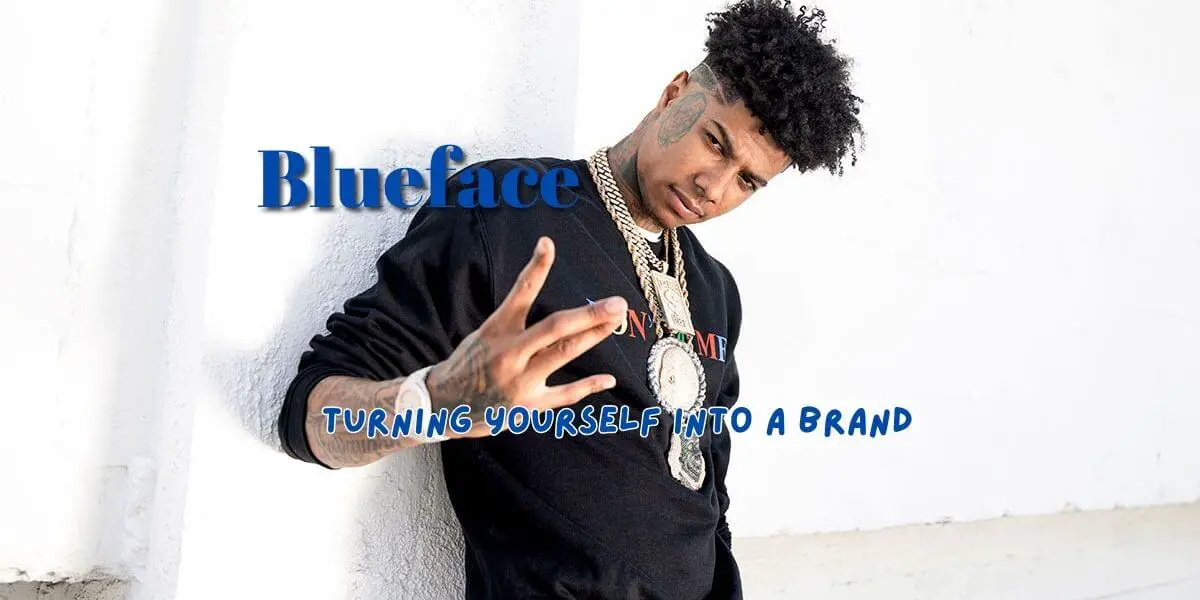Blueface (American Rapper) – Turning Yourself Into A Brand Like a Blueface
The phenomenon of turning oneself into a brand has gained considerable attention in contemporary society. This article explores the case study of Blueface, an American rapper who has successfully transformed himself into a recognizable brand.
By analyzing the strategies employed by Blueface, this article aims to provide insights into building a unique persona, leveraging social media and digital platforms, and navigating controversies and challenges.
Through an objective and analytical lens, this article sheds light on the factors contributing to Blueface’s longevity and potential legacy in the music industry.
Key Takeaways
- Personal branding is important for success in the digital age
- Blueface has successfully crafted a brand that resonates with his audience through his authenticity in music and persona
- Blueface’s unique music style and controversial image have helped him make a significant cultural impact in the music industry
- Leveraging social media and digital platforms is crucial for personal branding, as seen in Blueface’s successful social media strategy and collaborations with other influencers and artists.
Personal branding has become increasingly important in today’s digital age, where individuals have the opportunity to create and curate their online presence. Blueface, through his unique style and self-expression, has successfully crafted a brand that resonates with his audience. His authenticity shines through in his music and persona, allowing him to connect with fans on a deeper level.
Moreover, his active engagement with his audience through social media platforms has further solidified his brand. By leveraging these tools, Blueface has effectively transformed himself into more than just a rapper but a recognizable and influential brand.

The Rise of “Blue Face”( An American Rapper
In the contemporary realm of the music industry, the ascent of “Blue Face,” an American rapper, is a remarkable testament to the power of individuality and viral appeal. Blue Face’s meteoric rise from obscurity to stardom exemplifies the potency of harnessing unconventional elements within the genre.
What sets Blue Face apart is his lyrical prowess and distinctive visual identity, prominently highlighted by his signature blue face tattoos. This audacious branding choice not only caught the attention of the masses but also helped him carve an indelible niche in the competitive hip-hop landscape.
Blue Face’s journey embodies the transformative nature of modern self-branding. His early music releases, marked by their unfiltered and raw nature, resonated with a generation seeking authenticity and unpretentious storytelling.
The rapper’s strategic use of social media platforms, especially Instagram and TikTok, was pivotal in propelling his music to viral status. His content, characterized by its catchy hooks and irreverent lyrics, became a staple for internet memes and challenges, turning listeners into active participants in his artistic narrative.
The rapper’s rise to fame had its fair share of controversies. Critics questioned the sustainability of Blue Face’s fame, dismissing him as a one-hit-wonder. However, the artist strategically capitalized on the attention, leveraging his notoriety to explore avenues beyond music.
Collaborations with fashion brands and appearances in reality TV shows showcased his multifaceted persona, elevating him from a rapper to a bonafide pop culture icon.
The story of Blue Face serves as a quintessential case study in the modern music industry, underscoring the importance of embracing one’s unique identity and employing unconventional strategies for self-promotion.
His ability to seamlessly merge his audacious visual branding with his musical talents demonstrates the potency of a holistic approach to self-expression.
Authenticity as the Core for an American Wrapper
Authenticity lies at the heart of establishing a strong personal brand, as exemplified by the rise of Blueface in the music industry. In today’s highly competitive market, artists must differentiate themselves and create a unique identity to stand out. This is where authenticity plays a crucial role.
By staying true to themselves and presenting an authentic personal image, artists can connect with their audience on a deeper level. Blueface, with his unapologetic and raw style, has effectively utilized authenticity as a branding strategy. His unfiltered lyrics and unconventional flow resonated with fans, increasing fan engagement and support.
Moreover, authenticity not only helps in building a loyal fan base but also contributes to career sustainability. By maintaining a genuine persona, artists can establish trust and credibility, allowing them to navigate the ever-changing music industry successfully.
Building a Unique Persona
Central to Blue Face’s journey of transforming into a brand is the art of crafting a distinctive persona that resonates with audiences. At the heart of his success lies the fusion of his music with an unconventional visual identity, the iconic blue face tattoos.
This deliberate choice distinguishes him from the homogeneous landscape of rappers, instantly imprinting his image in the collective consciousness. Blue Face’s persona exudes authenticity and unfiltered expression, aligning seamlessly with the desires of a modern audience seeking genuine connections.
His unique persona extends beyond mere aesthetics. Blue Face’s lyrical content, characterized by its unabashed storytelling and audacious delivery, further solidifies his individuality. The juxtaposition of his unapologetically honest lyrics against infectious beats creates an irresistible charm that transcends conventional boundaries.
This deliberate blending of his distinctive appearance, unfiltered narratives, and infectious music has forged an authentic connection with fans, transforming them into loyal advocates of the Blue Face brand.
In a digital age dominated by fleeting trends, Blue Face’s persona is a testament to the enduring power of authenticity. By embracing his true self and channeling it into his art, he defies the need for conformity, inspiring others to do the same.
Blue Face’s journey underscores that building a unique persona isn’t just about surface-level aesthetics; it’s about cultivating an unshakable identity that captures attention, forges connections, and stands the test of time.

Leveraging the Social Media and the Digital Presence of Blue Face, the American Rapper
Leveraging social media and digital platforms is a strategic approach for artists to enhance their visibility and connect with a wider audience, as demonstrated by Blue Face’s successful utilization of these channels. Blue Face’s social media strategy and digital marketing efforts have played a crucial role in establishing his personal brand and online presence. Through consistent and curated content, he has built a strong following and engaged with his audience effectively. His success can be attributed to several key factors:
- Content Authenticity: Blue Face’s social media posts and digital presence reflect his unique personality and style, allowing fans to connect with him on a deeper level.
- Strategic Collaborations: He has effectively collaborated with other influencers and artists, expanding his reach and attracting new followers.
- Engaging Storytelling: Blue Face’s ability to tell compelling stories through his social media posts has captivated his audience and kept them engaged.
- Consistent Interaction: He actively engages with his followers by responding to comments, hosting live streams, and conducting Q&A sessions, fostering community.
Blue Face’s success in leveraging social media and digital platforms provides valuable insights into effective personal branding and influencer marketing strategies.
Engaging with the Audience
Engaging with the audience involves actively interacting with followers, responding to comments, and fostering community through various online platforms. Audience interaction is crucial for building brand loyalty and establishing a strong online presence.
Communication strategies that encourage two-way communication and active participation should be employed to engage with the audience effectively. This can include responding to comments and messages, hosting live Q&A sessions, and soliciting feedback from followers.
Community building is another important aspect, as it creates a sense of belonging and encourages followers to remain engaged with the brand. Content creation plays a vital role in engaging the audience, as it should be relevant, compelling, and tailored to the preferences and interests of the target audience. By consistently engaging with the audience and creating valuable content, brands can cultivate a loyal following and establish a strong online presence.
Consistency and Evolution
Consistency and evolution are crucial when building a successful brand, as they contribute to maintaining relevance and adapting to changing market conditions. To achieve this, brands must engage in creative experimentation, fostering personal growth and adapting to emerging trends.
- Creative experimentation allows brands to push boundaries and explore new ideas, fostering innovation and differentiation. It enables them to stand out in a crowded marketplace and capture consumers’ attention.
- Personal growth is essential for brands to evolve and stay relevant. Brands must continuously learn and adapt, embracing new technologies, strategies, and consumer preferences. This growth mindset allows them to remain agile and responsive in a rapidly changing business environment.
- Adapting trends is crucial for brands to stay current and resonate with their target audience. By understanding and integrating the latest trends into their brand identity and messaging, they can maintain relevance and connect with consumers on a deeper level.
- Brand evolution is an ongoing process that involves continuously assessing and adjusting brand strategies to meet evolving market demands. Brands must be willing to evolve their products, services, and messaging to stay ahead of the competition and meet their customers’ ever-changing needs and expectations.
Collaborations and Expansion
Collaboration and expansion can be effective strategies for brands to increase their market presence and tap into new customer segments. By seeking collaboration opportunities and forming brand partnerships, companies can leverage the strengths and resources of other entities to achieve mutual benefits.
For artists like Blueface, collaborating with other musicians or brands can increase exposure and access to international markets. These partnerships can also foster artistic growth, exposing artists to new perspectives and creative influences.
Furthermore, collaborations and expansion can contribute to diversifying revenue streams, as brands can introduce new products or services to their existing customer base. However, with these opportunities come challenges and controversies that require careful handling to maintain brand reputation and consumer trust.
Handling Controversies and Challenges
Navigating controversies and challenges effectively is crucial for brands to maintain their reputation and ensure long-term success in the industry. To handle such situations, brands need to have a strategic approach to managing their public image. This involves crisis management techniques that allow brands to address and mitigate any negative impacts on their reputation.
Dealing with negative press requires brands to be transparent, responsive, and proactive in addressing concerns or criticisms. Maintaining fan loyalty is another important aspect, as brands must engage with their audience, listen to their feedback, and address their concerns.
Overcoming personal challenges is essential for brands to demonstrate resilience and adaptability, ultimately earning the trust and respect of their audience.

Longevity and Legacy
To ensure long-term success and establish a lasting legacy, brands must strategically position themselves within the industry and continuously adapt to changing market dynamics. Longevity strategies are crucial for creating a lasting impact and leaving a legacy.
Maintaining relevance is key to building a timeless brand. One effective longevity strategy is to focus on innovation and stay ahead of the curve. By constantly evolving and introducing new products or services, brands can maintain relevance and appeal to consumers.
Another strategy is building strong customer relationships, and fostering loyalty and trust. This can be achieved through personalized experiences, exceptional customer service, and consistent quality.
Brands should invest in marketing and branding efforts to ensure their message is consistently communicated and resonates with their target audience.
Conclusion
In the world of music, few have been able to turn themselves into a brand quite like Blueface, the American rapper. Through his unique persona and authentic approach, he has captured the attention of millions and built a strong digital presence.
Blueface has expanded its reach and faced controversies by leveraging social media and collaborations. However, his longevity and legacy remain to be seen.
Like a blue face in a sea of colors, Blueface has emerged as a true standout in the rap game.




